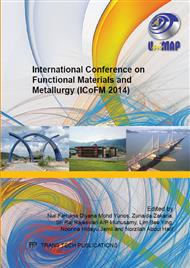p.9
p.15
p.20
p.25
p.31
p.39
p.45
p.50
p.57
Reduction Behaviour of Iron Ores by Agricultural Waste Chars
Abstract:
Iron and steelmaking are two of the largest energy intensive industries with the highest growth rate in energy consumption of all energy utilisation sectors. In order to meet the growing greenhouse challenges, incorporation of renewable resources to the existing and emerging metallurgical operation are desirable. In this respect, agricultural wastes can be potentially applied as fuel for ironmaking process to stabilise the greenhouse emissions as it is renewable and CO2 neutral. Thus, the present study investigates the reduction behavior of iron ore minerals and growth of metallic iron in reduction process. The process was utilized palm shells char (pyrolyzed) as reducing agent at high temperature (1000°C) with inert gas oxygen within 2 hours of reduction reactions. Reducing agent plays a vital role in the reduction process where metallic iron was produced. After the reduction for sample mass ratio of 30:70 palm char over iron ore blend. Metallic iron produced was detected by XRD pattern as well as the other oxides through SEM/EDS analysis. The result indicates that palm shells char can be used as reducing agent by producing metallic iron effectively. The beneficial effect on the environment through decrease use of coke/coal consumption and carbon dioxide emissions in steelmaking process.
Info:
Periodical:
Pages:
31-36
Citation:
Online since:
June 2015
Keywords:
Price:
Сopyright:
© 2015 Trans Tech Publications Ltd. All Rights Reserved
Share:
Citation:


